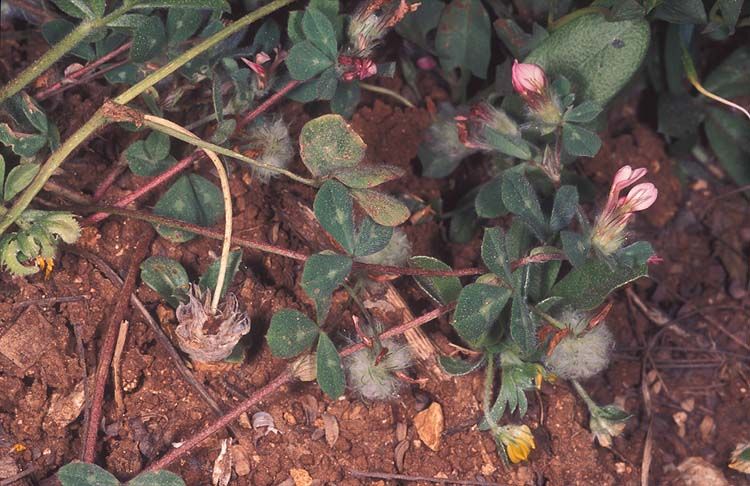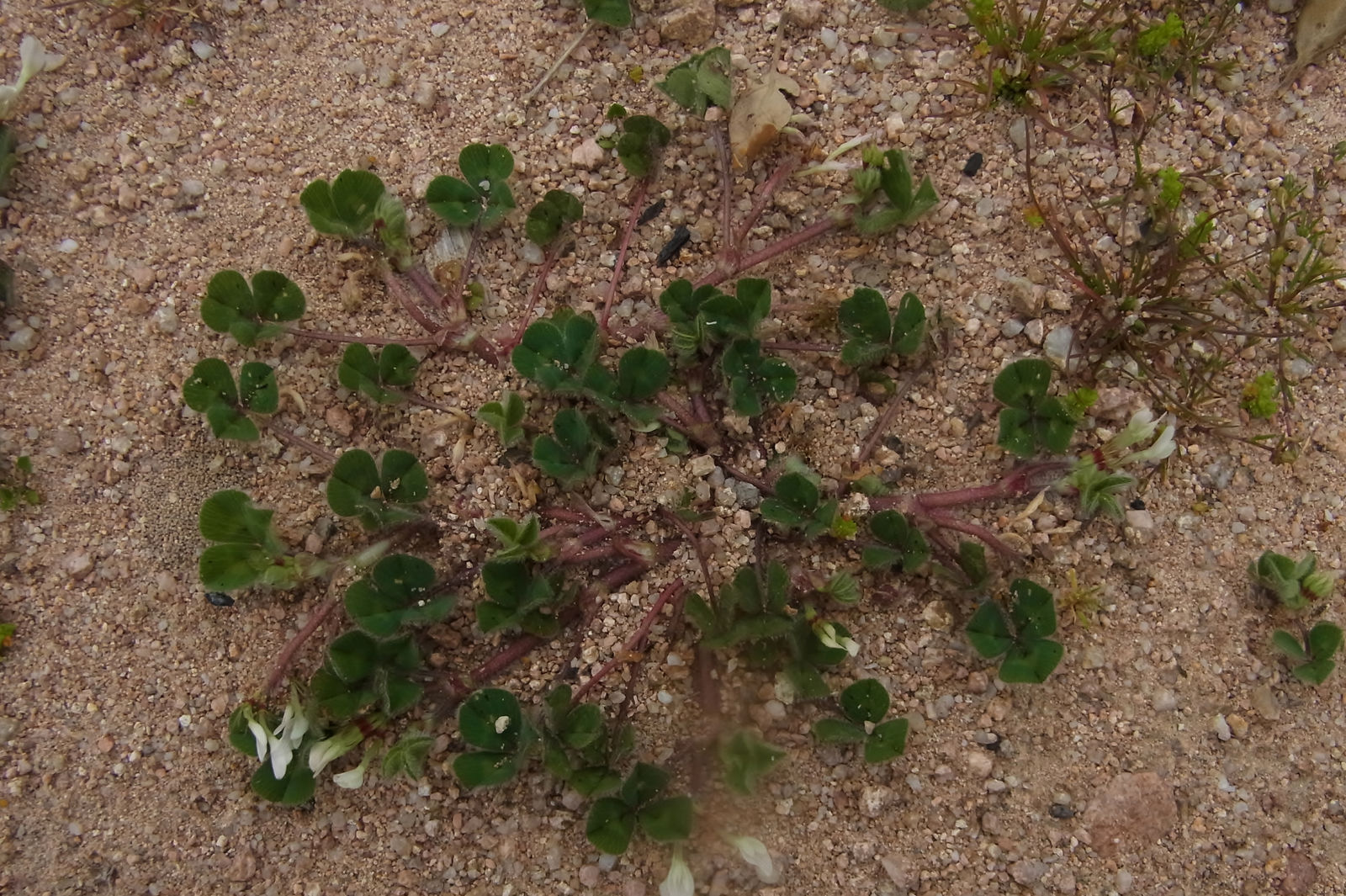Subterranean Clover
trifolium subterraneum
Also known as: ["Subterranean Clover","Subclover"]
Overview
A small, annual legume native to the Mediterranean region, known for its nitrogen-fixing properties and use in pasture improvement.
Benefits & Perks
["edible fruits","wildlife attractant (bees, butterflies, birds)","drought tolerant"]
Botanical Classification
| Phylum: | Magnoliophyta |
| Class: | Magnoliopsida |
| Order: | Fabales |
| Family: | Fabaceae |
| Genus: | Trifolium |
| Botanical Name: | Trifolium subterraneum |
Plant Characteristics
Basic Information
- Category: Herbs & Weeds
- Suitable Location: open pasture or garden bed with good air circulation
- Suitable For:
- Is Weed: No
- Allergenicity: low
Environmental Needs
- Climate: {"temperatureRange":"5–30°C"}
- Hardiness: {"zones":"8–10"}
- Misting: rarely required unless in very dry conditions
- Drainage: Fast-draining to prevent waterlogging.
- Soil Type: Well-draining loamy soil with added organic matter; tolerates sandy or clay soils if amended.
Maintenance Level
- Maintenance Level: low
- Toughness Level: moderate
- Pruning Frequency: As needed; after flowering or when plants become overgrown.
- Pruning Intensity: Light to moderate; avoid heavy pruning unless rejuvenating an older plant.
Care Details
Ideal Sunlight Coverage:
Full sun (6–8 hours/day); tolerates partial shade but may reduce flowering; adjust for extreme heat by providing afternoon shade.
Sunlight Tolerance Tips:
Acclimate gradually if moving from shade to sun; protect from intense midday sun to avoid scorching; for indoor placement, use a south-facing window with filtered light.
Care Requirements
Care Difficulty
easyeasy
Sunlight
full sun to partial shade
Rotate plants for even growth; use sheer curtains in summer; avoid direct sun during peak heat.
Watering
every 7–10 days during active growth, less frequently in dormant periods
Water at the base to avoid foliage wetting; ensure soil dries between waterings; adjust based on weather and growth stage.
Soil
well-drained, sandy loam with moderate organic content
pH: Slightly acidic to neutral (pH 6.0–7.0).
Avoid heavy clay soils; ensure good aeration; test pH before planting.
Temperature
Prefers cool to moderate temperatures (60–75°F or 15–24°C); tolerates mild frosts but avoid prolonged freezing; heat stress can occur above 85°F (29°C).
Monitor nighttime lows; protect from sudden temperature swings; adjust watering with temperature changes.
Fertilizing
every 4–6 weeks during growing season with balanced fertilizer
Fertilize sparingly to avoid leggy growth; cease feeding during dormancy; water before applying fertilizer.
Propagation
Methods
Seed propagation is most common; can also be propagated by division in early spring.
Step-by-Step Propagation Guide
- Prepare medium.
- Sow seeds or divide clumps.
- Water gently.
- Maintain consistent moisture.
- Transplant when true leaves appear or division shows new growth.
Best Time: Early spring or fall when temperatures are mild and humidity is moderate.
Environment
Warm (65–70°F or 18–21°C), humid, and partially shaded until established; direct sun can scorch young plants.
Medium
Well-draining seed starting mix or sandy loam; can be sown directly in garden beds.
Hormone
Not required for seeds; division requires no hormone.
Timeline
Seeds germinate in 7–14 days; plants establish within 4–6 weeks; division takes 2–4 weeks to re-establish.
Tools Needed
Seed trays, trowel, watering can, labels, pruners (for division).
Quick Tips
Sow seeds shallowly; keep soil consistently moist but not waterlogged; harden off seedlings before outdoor planting.
Pruning & Repotting
Pruning Guide
Method
Snip off spent flowers to encourage reblooming; trim leggy stems to promote bushier growth.
Pruning Plan
Minimal pruning needed; focus on removing dead or damaged foliage to improve air circulation and appearance.
Tools
Hand pruners, scissors, gloves.
Checklist
Disinfect tools; prune dead/damaged parts; remove spent flowers; clean up debris.
Repotting Guide
Best Season
Early spring before active growth begins.
Pot Size
One size larger pot (e.g., +2 inches in diameter); ensure good drainage holes.
Method
Remove plant gently; trim any circling roots; place in a slightly larger pot with fresh soil; water thoroughly after repotting.
Suggestions
Repot only if the plant is root-bound or outgrows its container; typically every 2–3 years.
Checklist
Check root boundness; prepare new pot; trim roots if needed; use fresh soil; water after repotting.
Advanced Care Tips
Watering Mastery
Watering Checklist
Check soil moisture; water deeply; ensure drainage; adjust seasonally.
How to Apply Water Properly
Water thoroughly until it drains from the bottom, ensuring even moisture reaches the root zone; avoid overhead watering to prevent fungal issues; water early in the day to minimize evaporation.
Watering Schedule Tips
Water deeply once the top inch of soil is dry; reduce frequency in winter to prevent root rot; increase during flowering and seed set periods.
Soil Improvement
Add compost or well-rotted manure for fertility; incorporate perlite or sand for drainage; use lime to raise pH if needed.
Temperature Stress Management
Signs of Temperature Issues
Chlorosis or browning of leaves; stunted growth; bud drop; wilting despite adequate water.
Cold Stress
Slows growth and photosynthesis; may cause leaf necrosis; can lead to winterkill in severe cases.
Solution: Mulch heavily to insulate roots; move potted plants to sheltered locations; avoid overwatering in cold conditions.
Hot Stress
Causes wilting, leaf scorch, and reduced flowering; may trigger premature seed set.
Solution: Provide shade during peak heat; increase watering frequency; use mulch to retain soil moisture.
Fertilizing Guide
Fertilizing Checklist
Check growth stage; dilute fertilizer; apply to soil; rinse tools after use.
Fertilizing Method
Use balanced liquid fertilizer diluted to half strength every 4–6 weeks during active growth; avoid fertilizing in winter; incorporate slow-release granules at planting time.
Common Problems & Solutions
Toxicity Warning
Cats
Non-toxicSubterranean clover is non-toxic to cats when ingested in normal amounts. It does not pose a significant health risk to felines.
⚡ Toxic If:
if eaten
Dogs
Non-toxicSubterranean clover is generally non-toxic to dogs when ingested in normal amounts. It is not known to cause significant adverse effects in canines.
⚡ Toxic If:
if eaten
Humans
Slightly ToxicTrifolium subterraneum, commonly known as subterranean clover, can cause bloat in humans if consumed in large quantities due to its high protein content and ability to ferment rapidly in the digestive system. This can lead to gas accumulation and discomfort.
⚠️ Symptoms:
🌿 Toxic Parts:
⚡ Toxic If:
if eaten in large quantities
Frequently Asked Questions
Q: Is Trifolium subterraneum suitable for home gardens?
A: Yes, it is suitable for home gardens, particularly in areas where nitrogen fixation is desired or for attracting wildlife.
Q: Can Trifolium subterraneum be used as a cover crop?
A: Yes, it is commonly used as a cover crop to improve soil fertility and structure.
Q: Does Trifolium subterraneum require much maintenance?
A: No, it is a low-maintenance plant that thrives with minimal care.
Quick Reference
| Family: | Fabaceae |
| Care: | easy |
| Light: | full sun to partial shade |
| Water: | every 7–10 days during activ |
Get Expert Care Tips
Download the Plantious app for personalized care reminders and plant identification!
Google Play App Store








